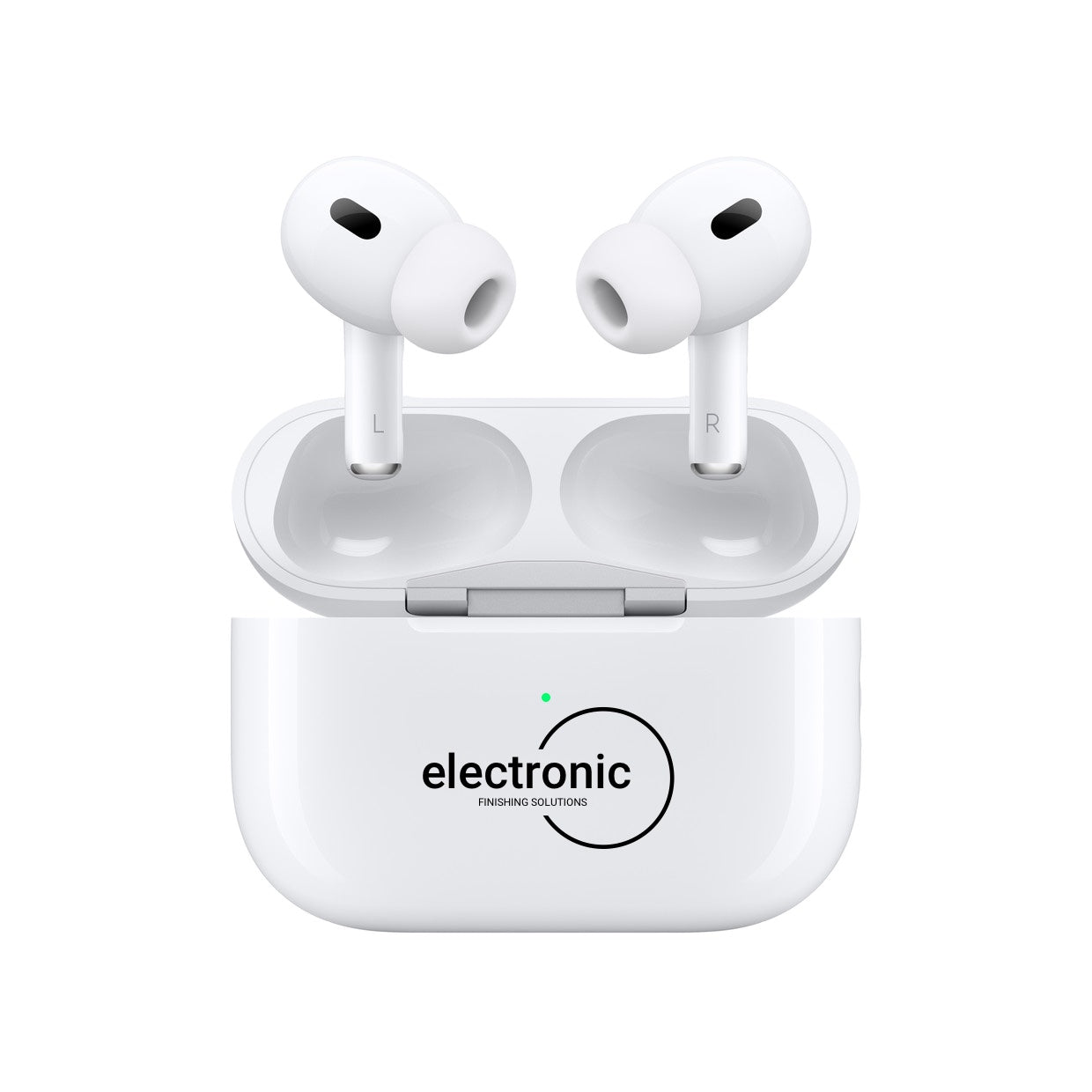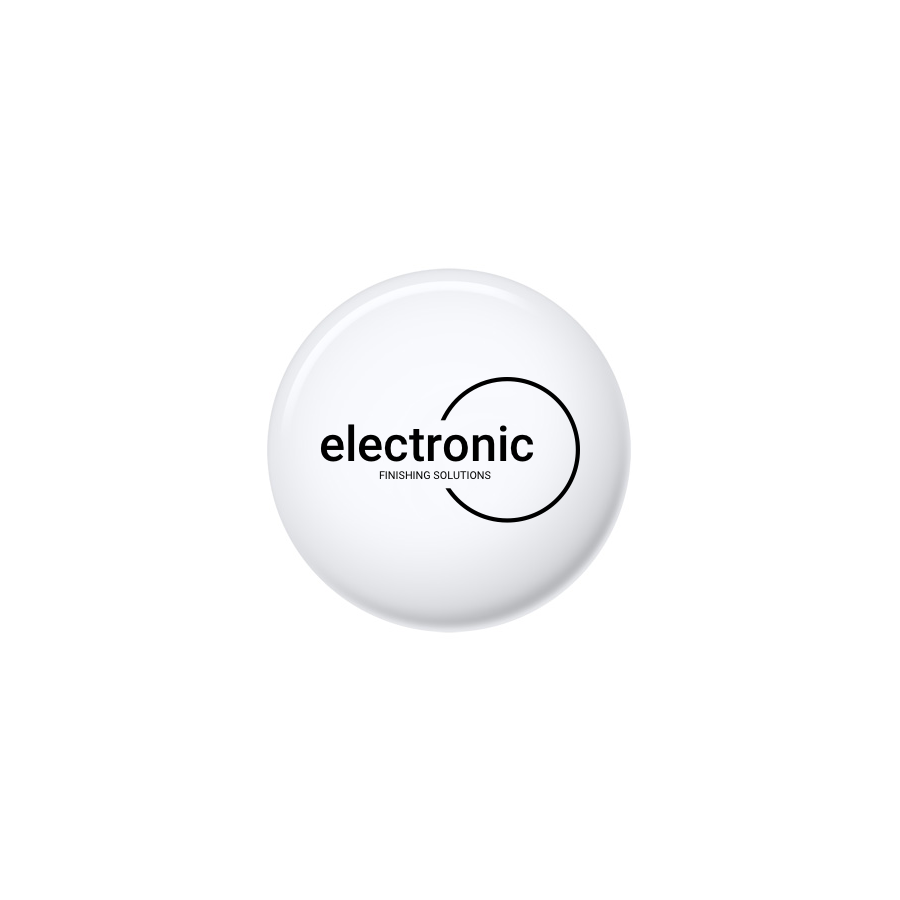What Direct to Consumer Fulfillment Really Means
Imagine a customer is browsing your website for promotional electronics. It's 11 PM on a Tuesday when they finally click "buy now" on a pair of custom-branded headphones. By Thursday afternoon, the package is on their doorstep. The unboxing is a delight, and your customer is thrilled. This seamless journey from click to unboxing is the heart of excellent direct to consumer fulfillment. It’s much more than just putting an item in a box; it's a strategic approach that gives your brand total control over the customer experience, turning a logistical task into a major business advantage.
This model marks a big change from traditional retail, where brands sell products in bulk to wholesalers or retailers who then manage the final sale to the customer. In the D2C world, you own the entire relationship. The diagram below shows how D2C strategies cut out these traditional middlemen, connecting you straight to your audience.
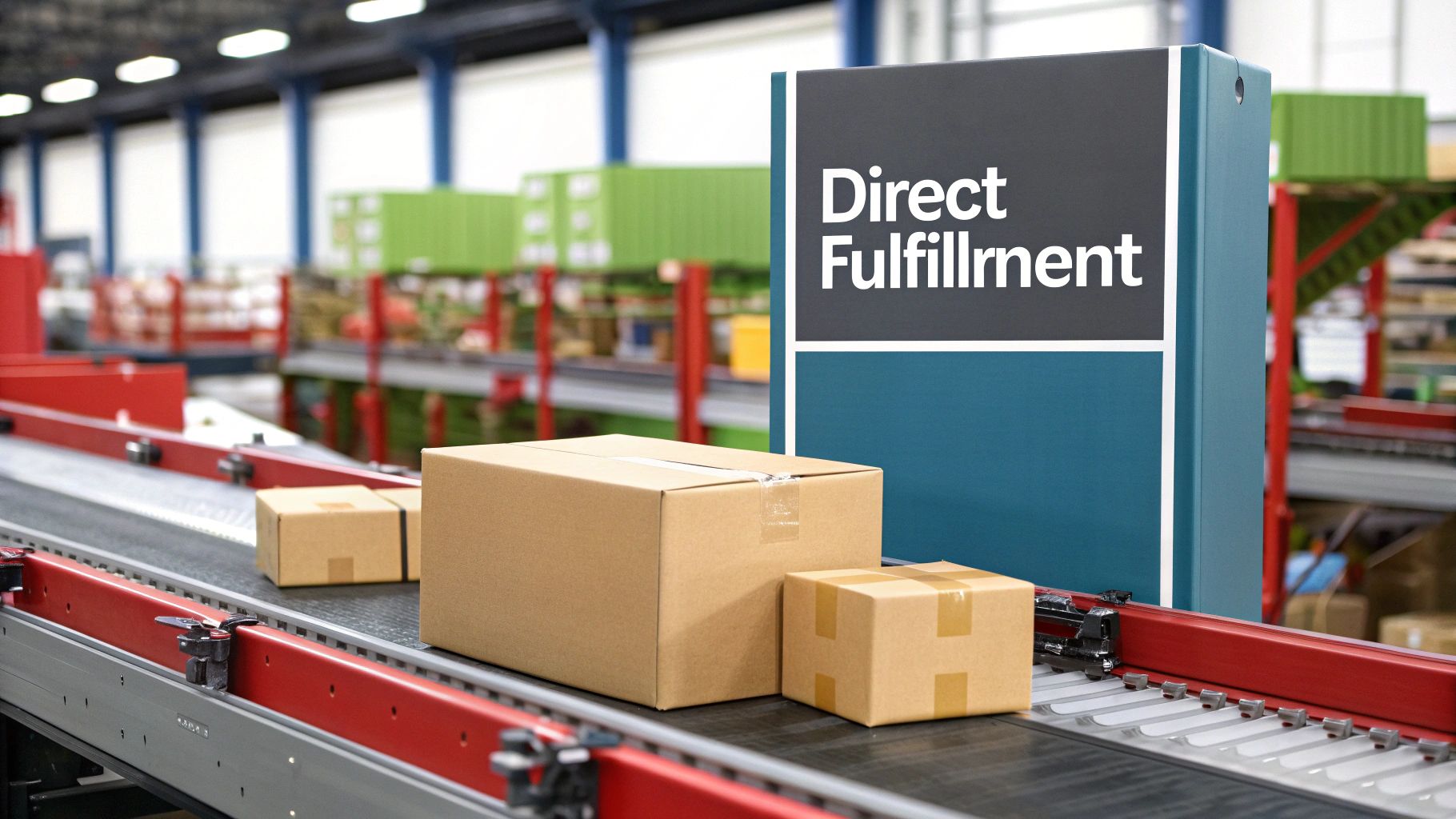
This direct connection is what makes the model so powerful. It allows brands to control their own story, collect firsthand customer data, and build a community around their products without any outside interference.
From Cost Center to Brand Builder
Viewing fulfillment as just another "cost center" is a common but expensive oversight. The most successful D2C brands know that the fulfillment process is one of the most direct and physical interactions a customer has with their brand. It's a prime opportunity to reinforce what you stand for, whether through sustainable packaging, a personalized thank you note, or simply a speedy, reliable delivery that beats expectations. For a closer look at the core ideas, you can explore the meaning of Direct to Consumer Fulfillment and how it reshapes business.
By managing every touchpoint from the warehouse shelf to the customer's front door, you ensure consistency and high quality. This control is essential for promotional electronics brands, where the condition and presentation of the product are everything. The outcome isn't just a sale, but a memorable experience that builds loyalty and generates positive word-of-mouth.
The Growing D2C Market
The move toward this model isn't a passing trend; it's a fundamental shift in how commerce works. The growth has been swift, particularly in key markets like the United States. D2C brands brought in about $135 billion in e-commerce sales in 2023, and that number is expected to climb to $187 billion by 2025. This rapid growth points to a change in how people shop, with more and more consumers wanting to buy directly from the brands they follow and trust. You can dive deeper into these figures by checking out statistics on D2C brand growth. This momentum shows why getting your fulfillment strategy right is no longer just an option—it’s crucial for survival and growth.
Inside the D2C Fulfillment Journey From Order to Doorstep
What happens in the crucial hours between a customer clicking "order confirmed" and receiving their package can define their entire perception of your brand. The journey of a promotional electronics product, like a pair of custom-branded headphones, is a multi-stage process where every detail counts. Let's trace this path from the warehouse to the doorstep to see how top brands create a smooth, reliable experience that builds trust and excitement.
The First Hour: Order Confirmation and Allocation
The moment an order is placed, a complex sequence of events kicks off. The first and most critical step is order confirmation, which immediately syncs from your e-commerce platform to a Warehouse Management System (WMS). This isn't just a simple notification; the system instantly checks inventory levels to ensure the product is available. For a promotional electronics brand, this could mean verifying stock not just for the headphones, but also for the specific custom packaging and any included inserts.
Once confirmed, the WMS allocates the inventory. Think of this like a restaurant kitchen receiving a new ticket. The system reserves the specific items for that order, preventing them from being sold to another customer. This initial step is vital for preventing overselling, a mistake that can severely damage customer trust. Brands that excel here can promise same-day shipping because their systems allocate inventory and create a picking ticket for the warehouse team within minutes.
From Shelf to Box: Picking, Packing, and Personalization
With an order ticket generated, the next stage is picking. This is where a warehouse associate, guided by the WMS, locates the products. There are several strategies here:
- Single-Order Picking: The picker gathers all items for one order at a time. This is simple but can be inefficient for high volumes.
- Batch Picking: The picker collects all the items needed for a group of orders simultaneously, which speeds up the process considerably.
- Zone Picking: The warehouse is divided into zones, and pickers are assigned to specific areas, passing orders along like an assembly line.
After picking, the items move to the packing station. For direct-to-consumer fulfillment, this isn't just about protection; it's a branding opportunity. A promotional electronics brand might use custom-branded boxes, include a personalized thank-you note, or arrange the products to create a memorable unboxing experience. Getting this right is important, as an impressive unboxing moment is often shared on social media, creating valuable organic marketing. Effective packing balances aesthetics with durability to ensure the electronics arrive safely.
To better understand how these fulfillment choices shape the customer experience, let's compare the D2C model side-by-side with traditional retail fulfillment.
D2C vs Traditional Fulfillment: Stage-by-Stage Breakdown
A detailed comparison showing how D2C fulfillment differs from traditional retail at each critical stage
| Fulfillment Stage | Traditional Retail Focus | D2C Approach | Customer Impact | Success Metrics |
|---|---|---|---|---|
| Order Processing | Bulk orders from a few retail partners. | Individual orders from thousands of customers. | Direct communication and personalization for each customer. | Order Accuracy Rate, Orders Processed per Hour |
| Inventory | Large, pallet-based stock in centralized warehouses. | Item-level stock, often across multiple locations. | Higher product availability and faster restocks. | Inventory Turnover, Stockout Rate |
| Picking & Packing | Case-picking or pallet-picking large quantities of the same item. | Piece-picking individual items for unique customer orders. | Branded, personalized unboxing experience. | Pick-to-Ship Time, Packing Accuracy |
| Shipping | Freight shipping (LTL/FTL) to retail distribution centers. | Parcel shipping directly to residential addresses. | Faster, direct delivery with real-time tracking. | On-Time Delivery Rate, Shipping Cost per Order |
| Customer Service | Handled by the retailer. The brand has no direct contact. | Managed directly by the brand, owning the entire relationship. | Direct feedback loop and stronger brand connection. | Customer Satisfaction (CSAT), Net Promoter Score (NPS) |
This table shows a fundamental shift: traditional fulfillment is about B2B efficiency, moving large volumes to a few destinations. In contrast, the D2C model is built around a B2C mindset, focusing on personal, accurate, and fast delivery to individual customers.
The following infographic illustrates how mastering these steps directly impacts key business outcomes.
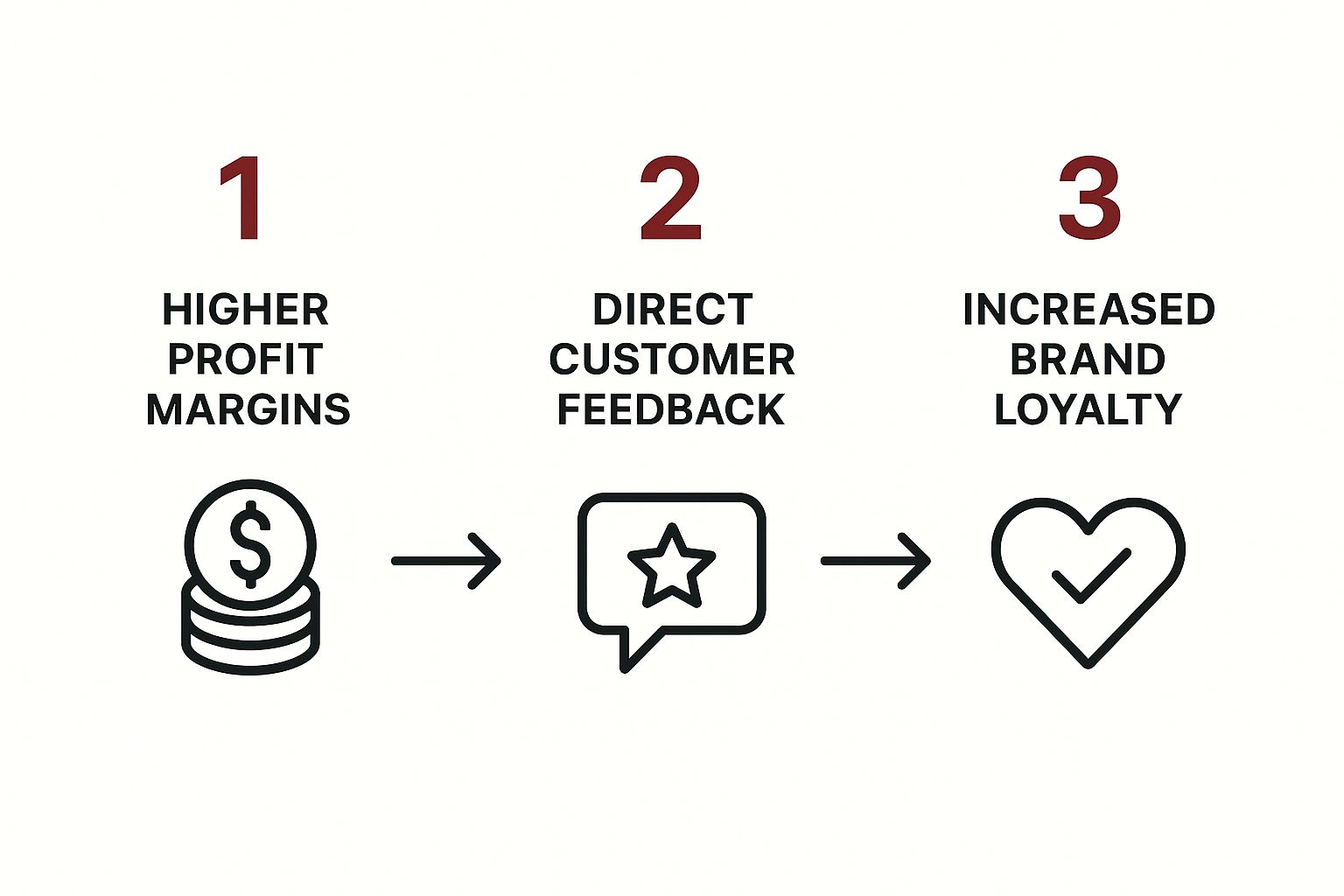
This visual shows that an efficient fulfillment process doesn't just cut costs; it creates a positive feedback loop where happy customers strengthen the brand. The final step is shipping, where the system selects the best carrier based on a combination of cost, speed, and destination. Once the package is shipped, a tracking number is sent to the customer, closing the loop and giving them visibility until the moment of delivery.
Choosing Your Fulfillment Strategy Without Costly Mistakes
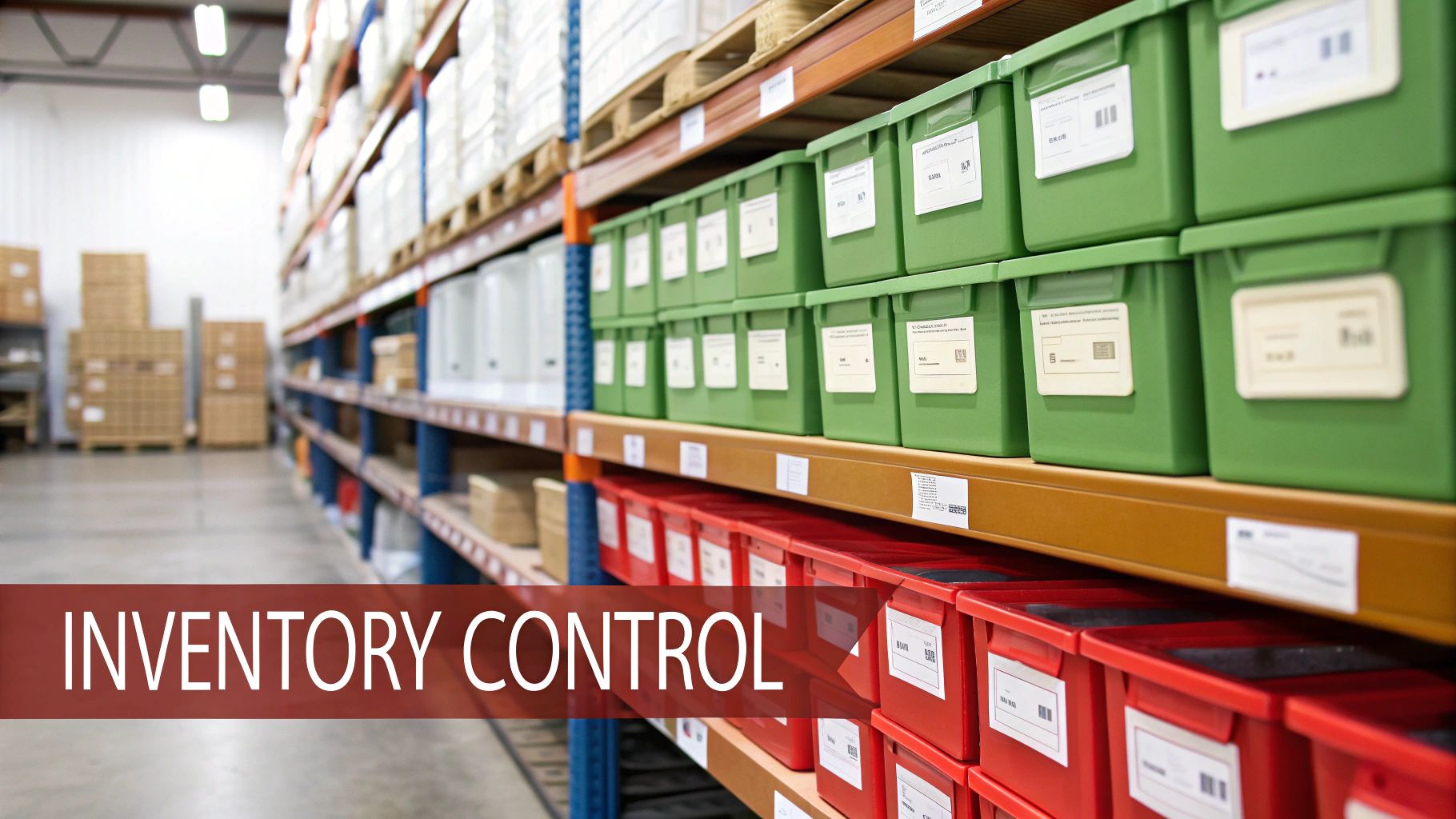
The reality is, a one-size-fits-all fulfillment solution doesn't exist for D2C brands. Picking the wrong approach can quickly lead to unhappy customers, wasted funds, and significant stress. For a promotional electronics brand, this decision carries extra weight, as the way your products are handled and presented is a direct reflection of your brand's commitment to quality. Let's walk through the main options and figure out which path aligns with your business.
This isn't just a cost-based decision. It's a strategic choice that demands a close look at your order volume, how complex your products are, and your ambitions for growth.
Three Core Fulfillment Models
When you're setting up your direct to consumer fulfillment operations, you'll generally encounter three primary models. Each presents a unique balance of control, cost, and the ability to scale.
-
In-House Fulfillment: Think of this as the DIY approach. You manage every single detail: leasing the warehouse space, hiring staff, implementing software, and negotiating shipping rates. This path gives you maximum control over the customer experience. You can personally ensure the custom packaging for your branded electronics is perfect and that every order meets your high standards. However, it also requires the largest upfront investment in both money and time.
-
Third-Party Logistics (3PL): Here, you hand over the entire process to a specialized partner. Many businesses opt to work with Third-Party Logistics (3PL) providers to manage their inventory storage, order picking, packing, and shipping. This model effectively converts a fixed cost (like a warehouse lease) into a variable one, making it incredibly flexible for growth. As your order volume grows, your 3PL costs adjust accordingly. The trade-off is giving up some direct, hands-on control.
-
Hybrid Fulfillment: This model is a mix of the first two. A brand might choose to handle fulfillment for its most valuable clients or complex custom orders in-house, while letting a 3PL manage the standard, high-volume products. This approach provides a good balance between control and scalability, but it requires seamless coordination between your internal team and your external partner.
Deciding which model is the right fit is a major strategic move. For a deeper look into how these models apply specifically to corporate gifting, you can find valuable insights in our guide on corporate gift fulfillment strategies for growth. Making the right choice will support both your brand's reputation and your bottom line.
A Framework for Your Decision
To make the right choice, you need to look past simple cost breakdowns. The following table provides a clear framework to help you compare the models across several key factors, guiding you toward the best fit for your promotional electronics brand.
Fulfillment Model Decision Framework
Comprehensive analysis comparing in-house, 3PL, and hybrid fulfillment approaches across key business factors
| Fulfillment Model | Initial Investment | Monthly Costs | Control Level | Scalability Factor | Ideal Business Stage |
|---|---|---|---|---|---|
| In-House | Very High | High (Fixed) | Maximum | Low to Medium | Established, high-volume brands with unique fulfillment needs or exacting quality standards. |
| 3PL Partner | Low | Variable | Medium | High | Startups, fast-growing brands, and businesses expanding into new markets. |
| Hybrid Model | Medium | Mixed | High (Variable) | Medium to High | Mature brands with diverse product lines or multiple sales channels requiring different handling. |
Ultimately, the best fulfillment strategy is one that aligns with your brand's current stage and future goals. A startup can hit the ground running with a flexible 3PL partner. In contrast, a larger enterprise with very specific requirements for its promotional electronics might find the control offered by an in-house or hybrid model to be a better long-term investment.
How Technology Is Revolutionizing D2C Fulfillment
The world of direct to consumer fulfillment is moving fast, and the brands that embrace new tools first are gaining a serious advantage. These aren't abstract ideas; they are practical solutions being used by your competitors right now to create better customer experiences. From the warehouse floor to the customer's doorstep, technology is reshaping every part of the fulfillment journey.
Imagine a traditional fulfillment center as a classic library, where librarians search for books by hand, one by one. Now, picture a modern fulfillment center as a high-tech digital archive, where automated systems find and retrieve items with incredible speed and accuracy. This evolution is what makes services like same-day delivery a realistic option, even for smaller brands.
Automation and AI in the Warehouse
The most obvious upgrades are happening inside the warehouse. Automation, in the form of robotic sorters and autonomous mobile robots (AMRs), is a total game-changer. These machines work alongside human teams to:
- Dramatically lower picking errors, which is essential for high-value promotional electronics.
- Boost order processing speed, getting items from the shelf to a shipping box faster than ever before.
- Run 24/7 during busy seasons, helping brands manage holiday rushes without overwhelming their staff.
Beyond the physical robots, Artificial Intelligence (AI) acts as the unseen brain that fine-tunes the entire operation. AI-driven inventory management systems look at sales data, market trends, and even weather forecasts to predict demand with impressive precision. For a promotional electronics company, this means fewer stockouts of popular gadgets and less money tied up in products that aren't selling. This forecasting ability turns inventory management from a guessing game into a forward-thinking strategy. If you're looking for partners who are already using these advanced systems, our guide to the top 8 global fulfillment services for 2025 is a great resource.
Bringing Fulfillment Closer to the Customer
Technology is also changing the physical map of fulfillment. A major development is the growth of micro-fulfillment centers (MFCs). These are small, highly automated warehouses located in or near cities. By storing inventory closer to where customers actually live, MFCs help solve the "last-mile" delivery problem—the most costly and difficult part of shipping. By 2025, MFCs are expected to be a common part of the D2C landscape, allowing brands to offer faster and cheaper deliveries in busy urban areas. You can read more about this and other future D2C fulfillment innovations to see where the industry is headed.
This approach lets promotional electronics brands match the delivery speeds of giant online retailers without needing to build enormous distribution centers. By working with fulfillment providers that operate networks of MFCs, even growing brands can offer next-day or same-day delivery to their most important urban customers, turning fulfillment into a true competitive advantage.
Designing Fulfillment for the Mobile-First Customer
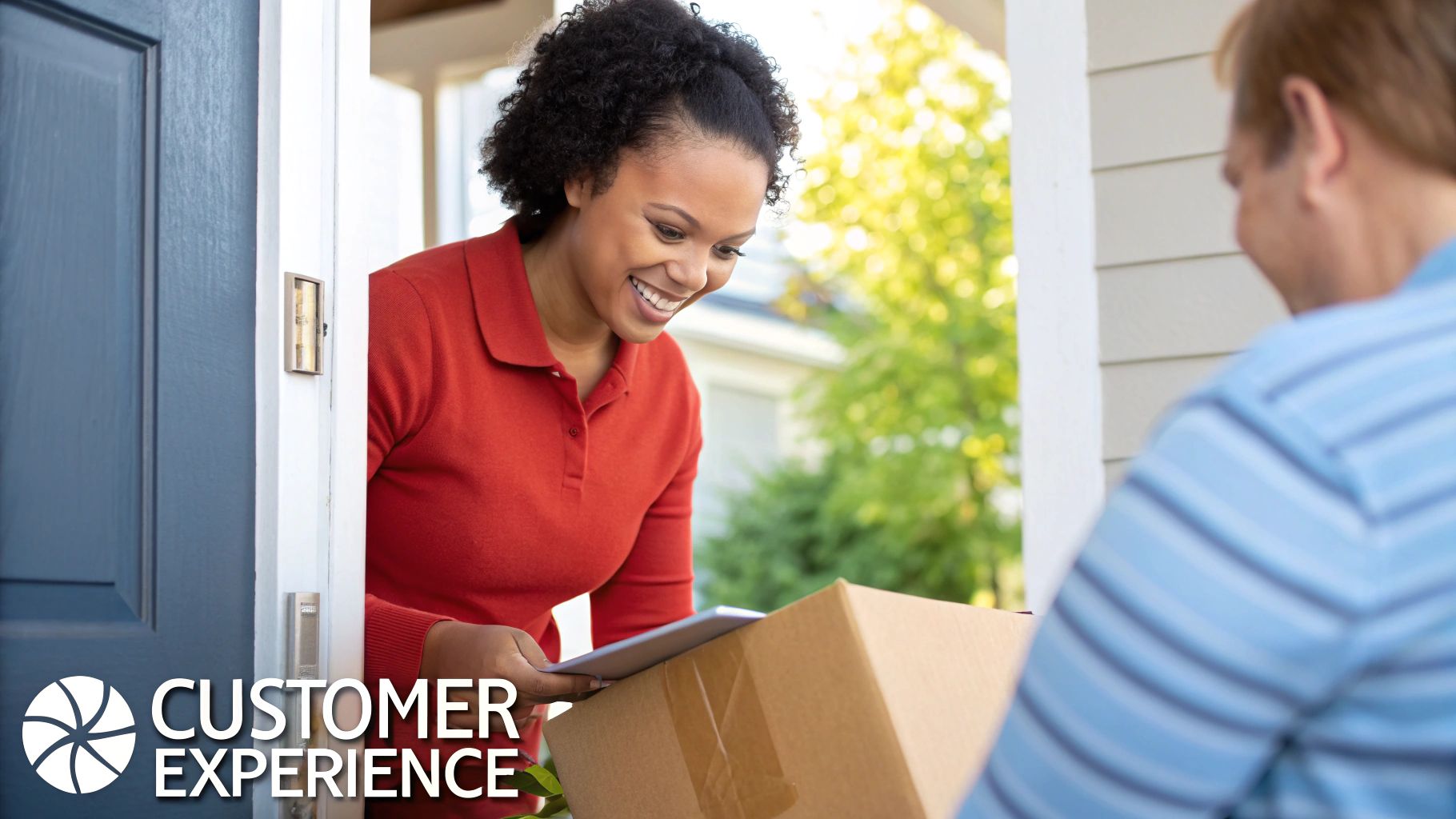
Today’s shoppers do more than just place orders on their phones; they expect to handle their entire relationship with your brand from their mobile device. This shift forces promotional electronics brands to rethink their direct to consumer fulfillment from the start. What used to be a simple string of email updates is now a critical mobile experience that directly shapes customer happiness.
Think about the old way of communicating fulfillment: it was like getting a paper map in the mail. The new mobile-first method is a live GPS with real-time updates and route changes. It's interactive and designed for the device in your customer’s hand. This means every touchpoint, from order confirmation emails to tracking pages, must look and work perfectly on a small screen. Brands that master this see a major drop in "Where is my order?" (WISMO) questions because customers feel informed and in control.
Adapting to New Mobile Expectations
The standards for mobile commerce have changed. Simply having a mobile-friendly website isn't enough anymore; customers expect a more connected and immediate experience. By 2025, mobile commerce is projected to make up over 60% of global online sales, with a value around $2.51 trillion. This huge market share shows that a mobile-ready fulfillment process isn't just a bonus—it's a core part of your business strategy. You can explore online shopping statistics worldwide to see more on these numbers.
This change has set new standards for the post-purchase journey. Key mobile-driven trends now shaping what customers want include:
- Real-Time Push Notifications: Customers would rather get instant updates sent to their phones than search through their email for shipping information.
- Visual Proof of Delivery: A simple "delivered" text message doesn't cut it anymore. Customers now want a photo of the package on their doorstep, which offers peace of mind and helps settle disputes over missing items.
- Seamless Mobile Returns: A difficult return process is a big turn-off. A mobile-first system lets customers start a return, print a label, and schedule a pickup directly from their phone in a few quick taps.
Turning Mobile Fulfillment Into a Competitive Edge
For promotional electronics brands, these mobile-focused features are powerful ways to stand out. Imagine a client receiving a high-value corporate gift like custom-branded Bose speakers. A smooth mobile tracking experience with a photo confirmation not only ensures they get the item but also reflects the modern, high-quality image of your brand.
Additionally, making the return process simple builds a lot of trust. When a customer knows they can send something back without a hassle, they feel more confident about buying in the first place. By treating every mobile interaction as a chance to build trust and offer convenience, you can turn your fulfillment operations into a strong driver of customer loyalty and repeat business.
Turning Fulfillment Challenges Into Growth Opportunities
Every D2C brand eventually hits a wall. It might be a holiday rush that grinds your operations to a halt, or shipping costs that quietly eat away at your profit margins. These challenges aren't signs of failure; they are predictable growing pains. The real test of a brand’s strength isn’t avoiding these issues, but how it turns them into advantages. Top promotional electronics brands don't just solve problems—they build systems to anticipate and learn from them.
Instead of putting out fires, leading companies take control of common roadblocks in direct to consumer fulfillment. This change from a reactive to a proactive mindset is what separates struggling brands from market leaders. It’s about seeing a fulfillment mistake not as a disaster, but as a piece of data that can make your entire operation better.
From Roadblocks to Building Blocks
Let's look at some of the most frequent fulfillment challenges and how top-tier brands see them as opportunities for growth. This is where the operational side of your business can directly build customer loyalty and improve your brand's reputation. Smart solutions often require a mix of strategic planning, clear communication, and the right partnerships.
Here are a few practical examples of turning fulfillment pain points into strengths:
- Seasonal Demand Spikes: Rather than scrambling to hire temporary help for the holidays, successful brands use past data to forecast demand. They work with their fulfillment partners to plan capacity in advance, making sure they can handle the surge without sacrificing speed or accuracy. This turns a stressful time into a showcase of reliability.
- High Return Rates: Returns are a normal part of e-commerce. Instead of just processing refunds, insightful brands study return data to spot product flaws or unclear descriptions. They also create a simple, customer-friendly returns process, which can actually boost buyer confidence and long-term loyalty. An easy return shows customers you stand by your products.
- Controlling Shipping Costs: Rising shipping expenses are a constant pressure. Instead of just passing these costs to the customer, brands can work with fulfillment centers that offer rate shopping across different carriers. They might also use lighter, more efficient packaging for their electronics that still offers excellent protection. This approach helps keep pricing competitive and protects margins.
Building Resilience Through Smart Systems
Ultimately, the goal is to build a fulfillment ecosystem that is both strong and responsive. This means setting up clear quality control checkpoints to catch problems before products leave the warehouse. It also involves creating customer service procedures that empower your team to turn a delivery delay into a chance to provide outstanding support.
Good fulfillment is more than just moving boxes; it's a vital part of your brand strategy. For more ideas on how to connect your operations with customer relationship goals, check out our guide on expert corporate gift fulfillment strategies to boost relationships. By expecting challenges and building strong systems, you can make sure your fulfillment operations actively help your brand grow and succeed.
Building Fulfillment Operations That Scale With Success
A fulfillment strategy that works for a startup handling one hundred orders per month will buckle under the pressure of one thousand. This critical point is where many promising D2C brands falter, unable to grow gracefully. For promotional electronics companies, scaling direct to consumer fulfillment isn’t just about handling more boxes; it’s about maintaining quality and customer trust as order volumes multiply. The goal is to build an operation that doesn’t just survive growth but thrives on it.
Think about scalability from day one. Imagine your fulfillment operation as the foundation of a building. A foundation poured for a small cottage can't support a skyscraper. In the same way, an early-stage process built around manual spreadsheets and picking orders one by one will inevitably collapse during a holiday rush or a successful marketing campaign. Proactive planning is the key to avoiding this.
Key Pillars of a Scalable Fulfillment Strategy
To build an operation that can handle rising demand, focus on several core areas. These pillars ensure that as your sales grow, your customer satisfaction grows right along with it.
- Technology Integration: Your e-commerce platform, inventory management system (IMS), and warehouse software must communicate without a hitch. This prevents overselling, cuts down on manual data entry errors, and gives you a real-time view of your operations.
- Flexible Warehousing: Whether you manage your warehouse in-house or partner with a 3PL, your physical space needs to adapt. This could mean a layout that can be easily reconfigured or a fulfillment partner with a network of warehouses to support expansion into new regions.
- Data-Driven Decisions: Use data to see challenges coming. Analyze order trends to forecast inventory needs and track key performance indicators (KPIs) like order accuracy and on-time shipping rates. Understanding these numbers helps you fix weaknesses before they become major problems.
This screenshot from Shopify Fulfillment shows how modern platforms offer a central dashboard for managing orders and inventory, a vital tool for growing your business.
This unified view is essential. It provides the data needed to make smart decisions about inventory levels and operational efficiency, preventing stockouts and frustrating delays for your customers.
The Role of Smart Inventory Management
At the heart of any scalable fulfillment operation is excellent inventory control. To effectively scale your D2C fulfillment, implementing top inventory management best practices isn't just a good idea; it’s a necessity. This includes methods like ABC analysis to prioritize your high-value products and setting automatic reorder points to avoid running out of stock.
By mastering your inventory, you ensure your fulfillment process is a direct contributor to your bottom line. In fact, tracking the efficiency of these operations is a key part of how you measure marketing ROI and overall business success. A scalable system guarantees you can consistently deliver on your brand promise, no matter how fast you grow.
Ready to create an unforgettable brand experience with high-quality promotional electronics? At Electronic Finishing Solutions, we specialize in customizing top-tier gadgets and offer seamless direct fulfillment to make your corporate gifting effortless. Explore our solutions and get a free proof today!

